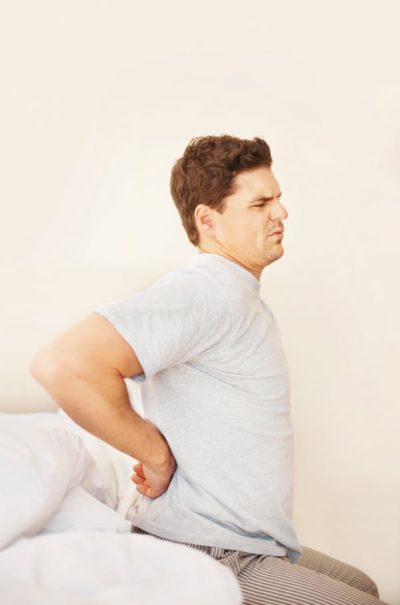Acute and Chronic Back Pain: Risk Factors and Treatment

Acute and chronic back pain is a common issue among adults affecting both men and women. At one point in our lives, most of us will experience it. There are several factors that can trigger this. A sore back can be the result of aging, an accident, or lack of exercise, among many others.
The pain can be sudden or increase over time. Either way, when the pain becomes too much to handle, it can also result in absences from work or missed appointments. In some cases, it can also lead to longer term disability if left untreated.
Types of Back Pain
Back pain is often classified between acute and chronic.
Acute back pain is also referred to ask short-term back pain. It can subside within a few days or weeks. It can heal on its own, without the need for medications or complex treatments, but often, if left untreated, it can become chronic. Normal function is usually restored once the source of the pain is treated.
Chronic back pain, is pain that lasts up to 12 weeks or longer. In many cases you can still feel pain even after the underlying cause has been treated.
Factors that Can Trigger Lower Back Pain
- Sedentary lifestyle. You’ll notice that back pain is more evident among people who lead a sedentary lifestyle or those who are not physically fit. Increased activity on weekends to compensate for lack of movement during the week can also cause back pain.
- Age. Back pain becomes more common as we grow older. This is typically due to reduced activity as people age. This doesn’t have to be a factor with proper exercise and resistance training.
- Weight. Obesity or excess weight gain can also put a strain on our back and cause it to feel sore.
- Nature of occupation. Jobs that are physically strenuous, such as those that require heavy lifting and pulling, can cause low back pain. These types of occupation also make individuals more prone to injuries. In addition, jobs that involve sitting all day in front of the computer can also contribute to back pain.
- Mental state. Stress, frustration, and anxiety can impact how a person deals with body pain. Your outlook can influence how you perceive the extent or gravity of your back pain. Stress takes a toll on our body, causing tension in our muscles.
- Pregnancy. The increase in weight and pelvic changes among pregnant women can result in low back pain. If you’re expecting, it’s crucial to ask your healthcare provider about appropriate exercises.
Treatment
The right approach for treating a sore back depends on whether you’re experiencing acute or chronic pain. Here are common types of treatments used to relieve low back pain.
- Applying hot or cold packs to the affected area. This is a common home remedy for alleviating back pain. It does not require medications and can also help bring relief, allowing a person greater mobility.
- Exercise. While rest is important when your back is aching, too much of it can also be harmful. Incorporating exercises into your daily activities, while avoiding extreme ones, can help lessen the pain. It’s best to coordinate with a healthcare provider, like a physiotherapist, to know more about exercises that can help improve your muscle balance and posture.
- Physiotherapy. Physiotherapy sessions help reduce pain, increase mobility, restore strength, and improve activity tolerance. The goal of physiotherapy is to help patients ease body pain to restore function. Part of the treatment is educating patients so similar situations can be avoided.
Physiotherapy for Treating
Physiotherapists are trained to diagnose the underlying causes of back pain. Our back consists of different structures such as nerve tissues, bones, ligaments, and muscles. And the pain you’re experiencing may be connected to either of these body parts.
Through a comprehensive assessment in our physiotherapy clinic here in Halifax, our physiotherapists can devise a treatment plan so you can manage, heal from, and keep your back pain from coming back.

Phone: (902) 425-3775
Fax: (902) 425-3774
ONE TO ONE WELLNESS CENTRE
1535 Dresden Row suite 210
Halifax, NS B3J 3T1
Copyright © 2025 One To One Wellness | All Rights Reserved | Powered by H-Cube Marketing